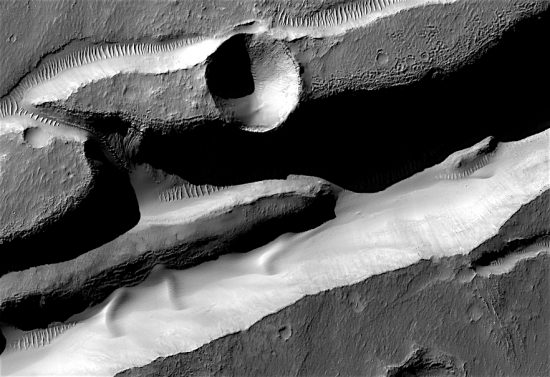
Dunes and Gullies in Sirenum Fossae. Credit: NASA/JPL/University of Arizona.
Jun 20, 2018
Did volcanic eruptions create fractures on Mars?
When electricity makes contact with a solid body, such as a planet, electric currents pull charged material from the surface. This results in circular craters, because electromagnetism causes the arcs to maintain right angles to the impact zone. In the Medusae Fossae region of Mars, semicircular craters are cut into the sides of many large hills, with the other half of the circle a trench. How can an impactor from space form a trench while cleanly slicing a rocky mesa?
The large cracks and fissures that can extend for thousands of kilometers across the planet’s surface are another oddity. A European Space Agency report discusses the Sirenum Fossae fracture system near the Tharsis uplift, part of a pattern extending outward from Arsia Mons, 1800 kilometers away.
Planetary scientists believe that the fractures on Mars are caused by the “…planet’s crust stretching apart as a magma chamber bulges the crust above it, or alternatively as the crust collapsed along lines of weakness as the magma chamber emptied.” Volcanic activity on Mars is based on observations of several formations, and the speculation that such formations behave like volcanoes on Earth.
A previous Picture of the Day described terrain found in Eastern Washington called the Channeled Scablands. Along with multi-kilometers-long ripples that march through the landscape with hundreds of meters between their crests, there are deep striations that are not easily explained. Rather than deposits or cuts from floods of water, it was suggested that they both could be the remnants of electric discharges.
There are other examples of dune-like formations, except they are on other planets, such as Mars, and on Saturn’s planet-sized moon, Titan. Along with the extraterrestrial examples, Australia’s Simpson desert contains 1240 parallel, unmoving “string dunes” that run for over 300 kilometers. They are not aeolian features, because they appear to be unaffected by the hot winds that frequently blow through the region and they do not travel.
The Namib desert also reveals thousands of square kilometers of hardened ridges that are covered by a thin veneer of sand. Instead of being dunes, per se, they are actually solidified stone that look as if a violent wind blew across molten magma, setting the ripples in place. Nearby are thousands of incised “gullies“, extending for hundreds of kilometers.
Electric Universe proponent Wal Thornhill proposes that a positively charged surface will be melted, while the electromagnetic forces within the arc might lift the surface to form a “lightning blister,” called a fulgamite. Arsia Mons, for example, demonstrates the results of such a discharge: a gigantic mound with several overlapping craters at the top and a vertical drop off at its edge. Such morphology belies a volcanic origin.
The advantage of the electrical interpretation is that it directly explains the nature of the topography dominating Mars. Electromagnetic forces between Birkeland currents constrained to a surface will force them into alignment. Ionic winds lift pulverized rock and carry it along in the direction of the current flow. Where a discharge channel bifurcates, the branches tend to remain parallel to each other and may rejoin. It is most likely electrical effects that carved the channels on Mars and in so doing formed the drifts of finely pulverized debris covering several thousand square kilometers in Sirenum Fossae.
Stephen Smith












